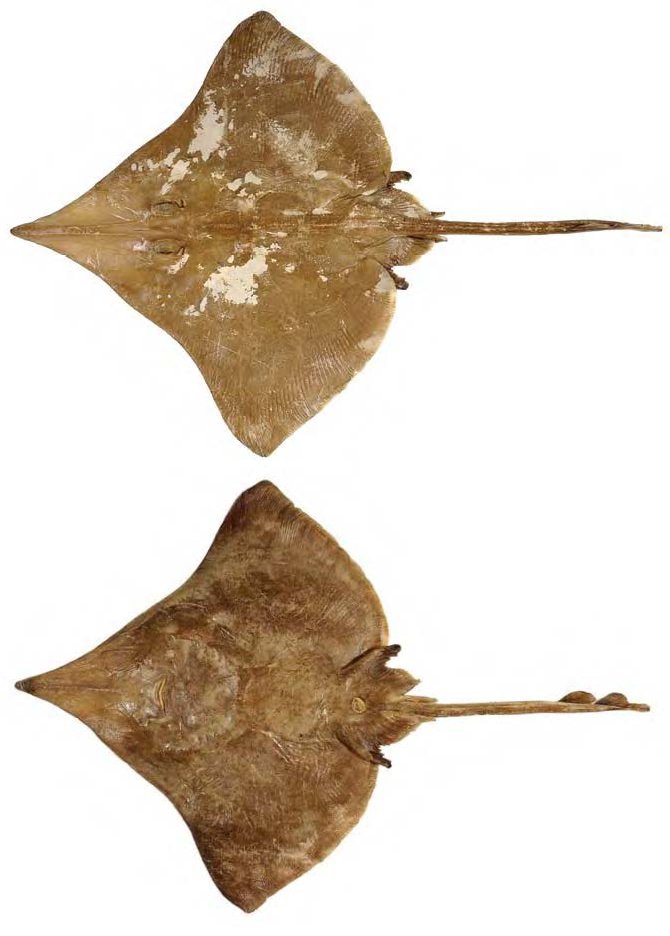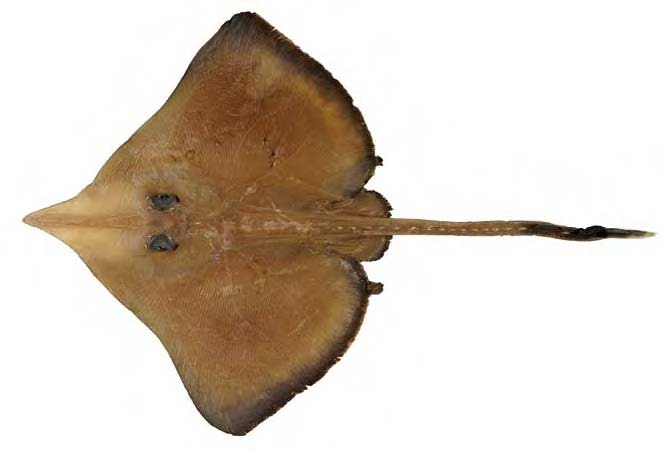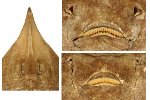Dipturus acrobelus
Last, White & Pogonoski, 2008
Deepwater skate
Classification: Elasmobranchii Rajiformes Rajidae
Reference of the original description
New skates of the genus Dipturus (Rajoidei: Rajidae) from Australian Seas. CSIRO Marine and Atmospheric Research Paper, 21, 9–52
New skates of the genus Dipturus (Rajoidei: Rajidae) from Australian Seas. CSIRO Marine and Atmospheric Research Paper, 21, 9–52
Image of the original description

Dipturus acrobelus sp. nov, adolescent male holotype (CSIRO H 226–01, 840 mm TL, preserved): A, dorsal surface; B, ventral surface. In: Last, P.R. & White, W.T. & Pogonoski, J.J. 2008 New skates of the genus Dipturus (Rajoidei: Rajidae) from Australian Seas. CSIRO Marine and Atmospheric Research Paper, 21: 9-52

Dipturus acrobelus sp. nov, adolescent male holotype (CSIRO H 226–01, 840 mm TL, preserved): A, dorsal surface; B, ventral surface. In: Last, P.R. & White, W.T. & Pogonoski, J.J. 2008 New skates of the genus Dipturus (Rajoidei: Rajidae) from Australian Seas. CSIRO Marine and Atmospheric Research Paper, 21: 9-52
Types
Dipturus acrobelus
Holotype: CSIRO: H 226-01; Paratype: AMS: I.44540-001; AMS: I.27722-007; CSIRO: H 6639-02; CSIRO: H 2654-01; CSIRO: H 2644-01; CSIRO: H 2637-01; CSIRO: H 879-01; CSIRO: H 871-01; CSIRO: H 789-04; CSIRO: H 789-03; CSIRO: H 558-02; CSIRO: H 614-01; CSIRO: H 223-01; CSIRO: H 54-01; CSIRO: H 53-01; CSIRO: H 51-01; CSIRO: CA 2805; CSIRO: T 456; CSIRO: H 1004-01; CSIRO: H 622-12; CSIRO: H 615-02; CSIRO: H 52-01; NMV: A 5938;
Dipturus acrobelus
Holotype: CSIRO: H 226-01; Paratype: AMS: I.44540-001; AMS: I.27722-007; CSIRO: H 6639-02; CSIRO: H 2654-01; CSIRO: H 2644-01; CSIRO: H 2637-01; CSIRO: H 879-01; CSIRO: H 871-01; CSIRO: H 789-04; CSIRO: H 789-03; CSIRO: H 558-02; CSIRO: H 614-01; CSIRO: H 223-01; CSIRO: H 54-01; CSIRO: H 53-01; CSIRO: H 51-01; CSIRO: CA 2805; CSIRO: T 456; CSIRO: H 1004-01; CSIRO: H 622-12; CSIRO: H 615-02; CSIRO: H 52-01; NMV: A 5938;
Description :
Citation: Dipturus acrobelus Last, White & Pogonoski, 2008: In: Database of modern sharks, rays and chimaeras, www.shark-references.com, World Wide Web electronic publication, Version 11/2025
Please send your images of "Dipturus acrobelus" to info@shark-references.com

Dorsal surface of Dipturus acrobelus sp. nov.: primary juvenile paratype (CSIRO H 789–03, female 214 mm TL, preserved). In: Last, P.R. & White, W.T. & Pogonoski, J.J. 2008 New skates of the genus Dipturus (Rajoidei: Rajidae) from Australian Seas. CSIRO Marine and Atmospheric Research Paper, 21: 9-52

Dorsal surface of Dipturus acrobelus sp. nov.: primary juvenile paratype (CSIRO H 789–03, female 214 mm TL, preserved). In: Last, P.R. & White, W.T. & Pogonoski, J.J. 2008 New skates of the genus Dipturus (Rajoidei: Rajidae) from Australian Seas. CSIRO Marine and Atmospheric Research Paper, 21: 9-52
Common names
 Deepwater skate
Deepwater skate
 Deepwater skate
Deepwater skate
Short Description
Original diagnosis of LAST, WHITE & POGONOSKI, 2008 [3309]: A large species of Dipturus (to 137 cm TL) with the following combination of characters: disc relatively broad with angular to narrowly rounded apices, width 66–71% TL, 1.1–1.2 times its length; snout angle 60–74°; tail length 0.7–1.0 in distance from snout tip to rear of cloaca; tail slender, somewhat rounded in crosssection and slightly expanded near its midlength, width 1.6–1.8 times height at its midlength, 1.4–1.8 times at first dorsal-fin origin; pre-upper jaw length 24–27% TL, 3.0–3.4 times internasal width; ventral head length 35– 38% TL; snout length 5.4–7.0 times interorbital width; orbit diameter 55–92% interorbital width; first dorsalfin height 1.2–2.1 in its base length; distance from first dorsal-fin origin to tail tip 3.0–4.2 times first dorsalfin base length, 2.6–3.5 times caudal-fin length; pelvic fins of medium size; anterior margins of both surfaces of disc of adult males and largest females (>1350 mm TL) with narrow bands of fine denticles; 1–3 nuchal thorns; malar thorn patch very well-developed; tail with 1–3 thorn rows (lateral rows poorly developed) in males, females with additional dorsolateral and occasionally weak ventrolateral thorn rows (up to 7 thorn rows in total); total pectoral radials 83–88; trunk centra 26–31; predorsal centra 78–85; total centra about 130–141; tooth rows in upper jaw 35–41; mainly uniformly pale grey to brownish dorsally; darker brownish or blackish ventrally (often mottled), snout tip darker than rest of snout; upper lip usually blackish bordering tooth band; ventral sensory pores very small, with indistinct dark edges; dorsal and caudal fins, tail tip, margins of pelvic fins, and posterior margins of pectoral fins black in juveniles (to at least 570 mm TL).
Original diagnosis of LAST, WHITE & POGONOSKI, 2008 [3309]: A large species of Dipturus (to 137 cm TL) with the following combination of characters: disc relatively broad with angular to narrowly rounded apices, width 66–71% TL, 1.1–1.2 times its length; snout angle 60–74°; tail length 0.7–1.0 in distance from snout tip to rear of cloaca; tail slender, somewhat rounded in crosssection and slightly expanded near its midlength, width 1.6–1.8 times height at its midlength, 1.4–1.8 times at first dorsal-fin origin; pre-upper jaw length 24–27% TL, 3.0–3.4 times internasal width; ventral head length 35– 38% TL; snout length 5.4–7.0 times interorbital width; orbit diameter 55–92% interorbital width; first dorsalfin height 1.2–2.1 in its base length; distance from first dorsal-fin origin to tail tip 3.0–4.2 times first dorsalfin base length, 2.6–3.5 times caudal-fin length; pelvic fins of medium size; anterior margins of both surfaces of disc of adult males and largest females (>1350 mm TL) with narrow bands of fine denticles; 1–3 nuchal thorns; malar thorn patch very well-developed; tail with 1–3 thorn rows (lateral rows poorly developed) in males, females with additional dorsolateral and occasionally weak ventrolateral thorn rows (up to 7 thorn rows in total); total pectoral radials 83–88; trunk centra 26–31; predorsal centra 78–85; total centra about 130–141; tooth rows in upper jaw 35–41; mainly uniformly pale grey to brownish dorsally; darker brownish or blackish ventrally (often mottled), snout tip darker than rest of snout; upper lip usually blackish bordering tooth band; ventral sensory pores very small, with indistinct dark edges; dorsal and caudal fins, tail tip, margins of pelvic fins, and posterior margins of pectoral fins black in juveniles (to at least 570 mm TL).
Remarks
shark-references Species-ID=1977;
shark-references Species-ID=1977;


















